‘To appreciate the beauty of Badrinath, explore the temple in summer.’
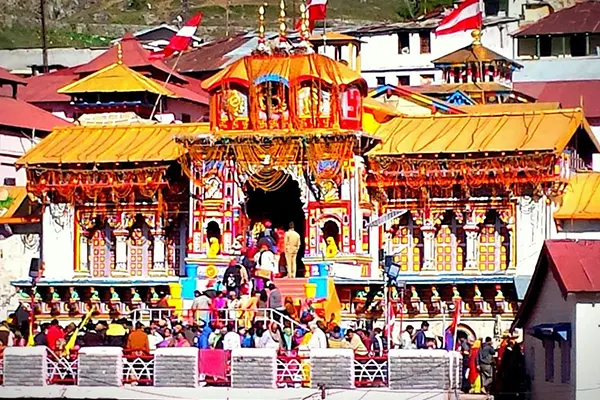
The best time to visit Badrinath is in the months of May to June and September to November. Badrinath Dham holds a special significance for Lord Vishnu devotees. During these months, the weather is delightful, with temperatures between 15°C and 20°C, making it perfect for outdoor activities and sightseeing. The winter season offers an enchanting experience at Badrinath, as the entire region gets covered in snow and temperatures drop below freezing point, creating a chilly ambience. However, due to icy conditions, heavy snowfall can sometimes obstruct the yatra and block the roads. Therefore, summer is considered the most suitable time to visit Badrinath, which also coincides with the best time to visit Kedarnath.
To ensure a spiritually fulfilling journey filled with positive vibes, you can book your Chardham Yatra by Helicopter Package through LIH Travel. Renowned as India’s top Chardham travel agent. Additionally, VIP travellers have the opportunity to avail luxurious facilities and comfortable accommodations along with VIP Darshan during their Chardham Yatra booking. Also check our Do Dham Yatra by Helicopter Tour package!
Badrinath Weather Information According to Months
| Seasons | Month | Temperature | Weather |
|---|---|---|---|
| Summers | April to June | 7-18°C | Sunny & Warm |
| Monsoon | July to September | 5-15°C | Moderate to Heavy Rainfall |
| Winter | October to March | -1-14 °C | Snowy (Snowfall) |
Overview of Badrinath Temple (Timings and Dates)
- Badrinath Temple Opening Date in 2025: 2 May 2025.
- Badrinath Temple Closing Date 2025: 2 November 2025.
- Badrinath Darshan Time 2025: 4:30 am to 1:00 pm.
Season Updates of Badrinath Dham
- Peak Season of Badrinath Dham: May to June and September to October.
- Off Season of Badrinath Dham: Winter (November to last April).
- Temperature of Badrinath Dham: The average temperature of Badrinath in summer is 18 degrees High to 7 degrees Low, and in the Monsoon Season, it is 15 degrees High to 5 degrees low.
- Best Weather to Visit Badrinath Dham: Summer is the best weather to visit Badrinath Dham; the weather is sunny and warm, and it is easy to trip to Badrinath.
Badrinath Weather in Summer (May to June)
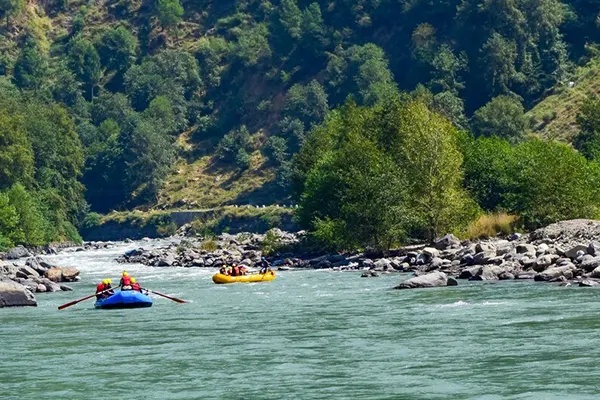
Summer is the best time to visit Badrinath. Badrinath experiences its summer months from May to June, where temperatures range from 7°C to 18°C. The weather during this time is pleasantly cool, making it a great opportunity for a divine visit to Badrinath Dham.
| Month | Temperature | Weather |
|---|---|---|
| March | 3°C to 11° | Snow Showers |
| April | 6°C to 16°C | Sunny & Balmy |
| May | 1°C to 22°C | Pleasent Weather |
| June | 9°C to 14°C | Sunny & Comfortable |
Essential Tips for Badrinath Yatra in the Summer Season
- Carry light, woollen clothes as the place remains cold even in summer.
- Carry a backpack instead of trolley luggage.
- Put on a pair of comfortable walking shoes or trekking shoes.
- Wear track pants, windproof jackets, sunglasses, and sun cap.
- Carry personal toiletries, a walking stick, and a torch with extra batteries.
- Keep extra energy drinks like Electoral or Gatorade to avoid dehydration.
- Do Not forget to bring a water bottle and some dry fruits to eat during the yatra.
Badrinath Weather in Monsoon (July to September)
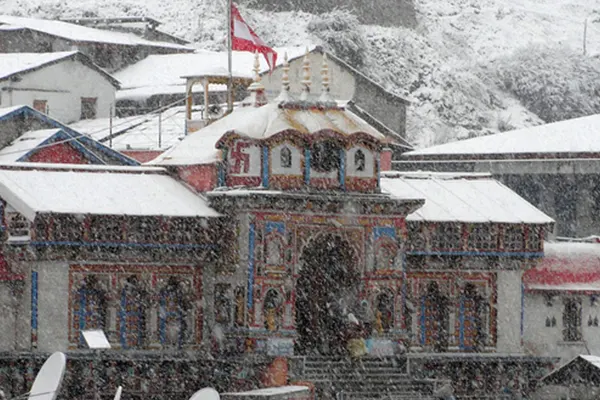
Rain Showers are frequent during the monsoon season, which begins in July and ends in September. During the monsoon, the sacred Badrinath Yatra Leads to one of the four Chardhams is not recommended. The occurrence of landslides may affect your pilgrimage. During this time, temperatures range from 5 to 15 degrees Celsius. In September, it begins to rain. As a result, the number of tourists increased again this month.
| Month | Temperature | Weather |
|---|---|---|
| July | 11°C to 14° | Average Rainfall |
| August | 12°C to 16°C | Heavy Rainfall |
| September | 11°C to 14°C | Balmy & Comfortable |
Essential Tips for Badrinath Yatra in Monsoon Season
- Carry a day pack with a rain-resistant cover.
- Think twice before purchasing your tickets during this season.
- Put on trekking pants, trekking shoes, waterproof hiking, and warm winter clothes.
- Carry Raincoats, thick woollen socks, water-resistant gloves, and thick fleece.
- Carry personal toiletries, a walking stick, and a torch with extra batteries.
- Keep extra energy drinks like Electoral or Gatorade to avoid dehydration.
- Not to forget to carry a water bottle and some dry fruits or eatables.
Badrinath Weather in Winter (October to April)
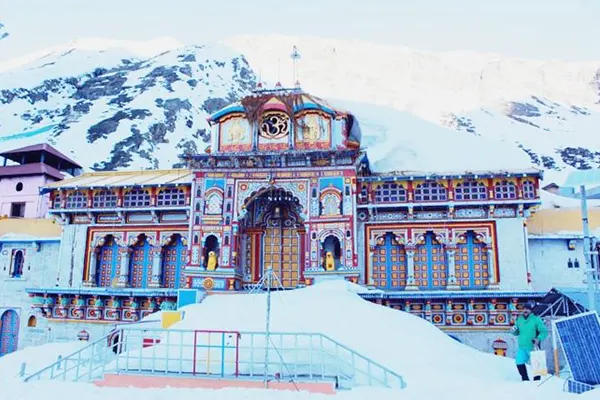
The winter season in Badrinath starts in October and continues until April. During this time, the days are extremely cold, with average minimum temperatures reaching as low as 5°C. It’s also the period when a substantial amount of snowfall occurs in Badrinath, and the temperatures drop below freezing. Due to the adverse weather conditions, the roads leading to Badrinath are currently closed. As a result, it is not advisable to visit this place during the winter season.
| Month | Temperature | Weather |
|---|---|---|
| October | 12°C to 17° | Cold Weather |
| November | 6°C to 14°C | Heavy Snowfall |
| December | 5°C to 12°C | Heavy Snowfall |
| January | 1°C to 8°C | Heavy Snowfall |
| February | 6°C to 10°C | Snow Showers |
| March | 3°C to 11°C | Snowy (Cold) |
Why Visit Badrinath Temple?
Badrinath Temple is one of the Chota Chardhams of Uttarakhand, along with Gangotri, Yamunotri, and Kedarnath. It is also one of the Char Dhams pilgrimage sites in India, along with Dwarka, Puri, and Rameshwaram. The temple is dedicated to Lord Vishnu and is also known as Badrinarayan Temple. With the breathtaking backdrop of the majestic Neelkanth Peak, this is one of the most revered pilgrimage sites. The temple’s many stories add to its charisma. The temple is open for six months and then closed for the rest of the year.
In the summer season, the weather in the region is mild and pleasant, which is the best time to visit Badrinath Yatra. During the monsoon season, the region experiences heavy rainfall, which increases the risk of landslides. Therefore, it is not advisable to travel during the monsoon season. However, if you are planning a tour to Badrinath during the monsoon season, you should allow for buffer days. During the winter season, snow falls in Badrinath. In September and October, the region experiences pleasant weather with a moderate cold, making these months the best time to travel to Badrinath Yatra. However, the temple is closed in November due to heavy snowfall.
Things to know before Visiting Badrinath
- The ideal time to visit the temple is from May to June and from September to October. The rest of the year, the temple remains closed due to heavy snowfall.
- It is strongly recommended to avoid the late winter and monsoon season. The region experiences heavy snowfall in winter and heavy downpours in monsoon, causing landslides and flooding.
- In the winter season, carry thick woollen clothes such as hats, socks, thermal pants, and gloves.
- If you are planning the Badrinath Yatra in summer, wear light woollen clothes.
- Always carry a first-aid kit with necessary medicines for fever, cold, cough, and altitude sickness. Also, take painkillers and antiseptic creams.
- Book your accommodation in advance, because during the high season, the chances of getting good accommodation at reasonable prices decrease.
- Take important documents with you, including tickets, cash, and a photo ID. Pack them in a waterproof bag during the monsoon and winter seasons.
Top Sights to See in Badrinath
Badrinath Temple

The Badrinath Temple, known as the Badrinarayan temple, is located in the Gharwal Himalayas, located on the banks of the Alaknanda River in Uttarakhand; it is one of the Char Dhams. The Char Dhams’ Names are Yamunotri, Gangotri, Kedarnath, and Badrinath. This Temple is devoted to Lord “Vishnu”. This temple is believed to have been established by sage Adi Shankaracharya in the 8th century. The best time to Visit Badrinath Temple is between May and June.f
Vasudhara Falls

Vasudhara Falls, which is located in Manali Village, is one of the famous tourist attractions. The water of Vasudhara Falls flows down from a height of 400 ft. It is believed that the water of Vasudhara Falls turns away from visitors who are not pure hearts.
Tapt Kund
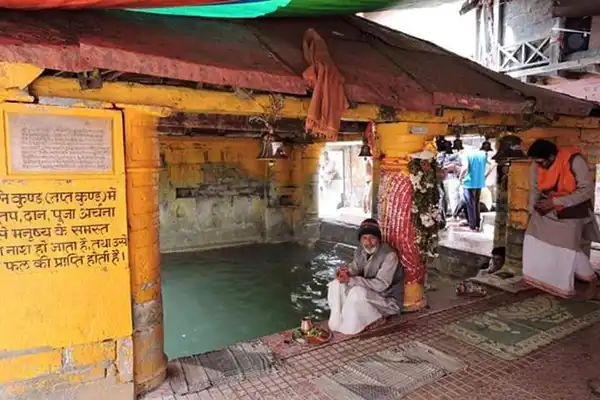
Tapt Kund is a hot water spriing, that liesbetween Badrinath Temple and Alakhnanda River. This thermal is situated in the Chamoli district of Uttarakhand. The Tapt Kund is a Natural hot water Lake whose temperature is up to 45 degrees.
Charan Paduka
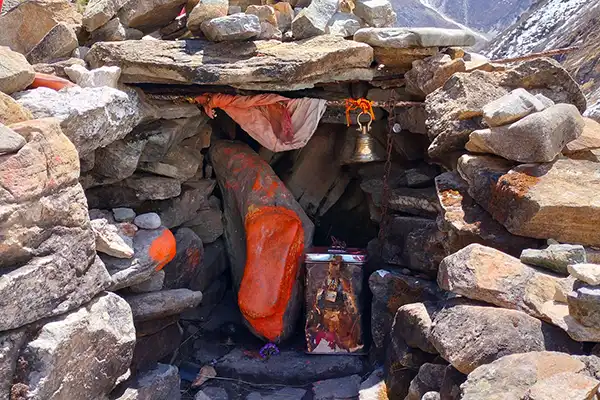
Charanpaduka is the first impression of Lord “Vishnu”, and it is one of the most popular tourist attractions. It is believed that when Lord Vishnu first came to earth, he had placed his first step on that stone.
Bheem Pul
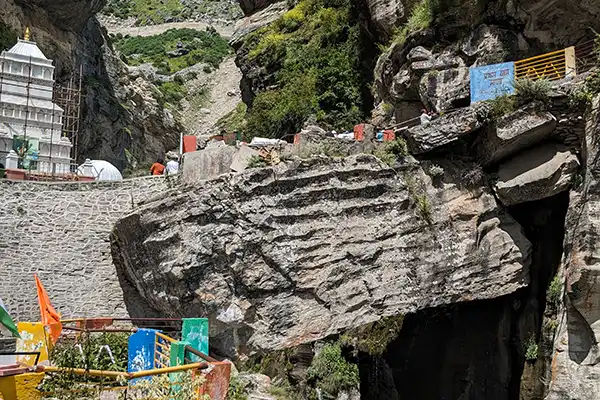
Bheem Pul is a natural stone bridge on River Saraswati near Badrinath, Uttarakhand. The Saraswati River flows with force in between the two mountains and joins with the Alakhnand River. Mahabali Bheem, one of five Pandav, threw a huge rock to create a path to join the two mountains so that Draupadi could easily walk over it.
Mana Village
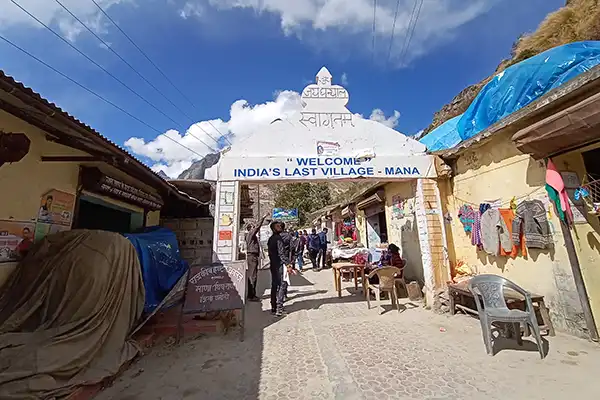
Mana Village is the last village of the Indian Territory at the China Border and is just 3 km away from Badrinath. It is located in Chamoli District.
Prepare a Trip for Badrinath Dham
Badrinath Dham is widely known for its importance in Hindu Mythology. Moreover, it is believed that to achieve salvation, a visit to the entire Chardham Yatra, which includes the Badrinath temple, is a must. Nestled in the Chamoli district in the Northern state of Uttarakhand, the place offers dynamic scenic sightseeing with the holy vibes of four adobes. Then, Plan your summer holiday to Badrinath and book your Badrinath Yatra by Helicopter with LIH.travel.
LIH.travel invites you to plan a holy trip to Badrinath at very affordable prices. Get the best advantage of helicopter services offered for the entire Do Dham Yatra by Helicopter service, which will help you reach Kedarnath & Badrinath Dham in a single day. Explore the holy shrines in Uttarakhand with ease and comfort and fly high.
Moreover, feel God through the chilly breezes surrounding the place and make it more pious. You can also check our Chardham Yatra by road package. The Chardham Yatra involves driving to all locations via car, which generally starts from Haridwar and is known as Chardham Gateway. With all the spiritual vibes, without thinking much, pick up your phone for the Badrinath Yatra Registration now.
Best Month to Visit Badrinath for a Peaceful Darshan Experience
If you’re someone who wants to visit Badrinath not just for the sake of going, but to actually sit quietly, close your eyes, and feel something, then your travel month matters more than you think. Most people rush in as soon as the temple opens in May. The vibe is grand, no doubt. Flowers everywhere, chants, drums, excitement, but also long queues, loud crowds, and barely a minute inside the temple. You’ll be pushed, asked to move quickly, and the experience won’t feel personal. If that kind of rush is okay with you, then it can be managed. But if you’re looking for peace? May and June are not for you.
The best month for a calm, peaceful darshan is September. The weather is considered perfect. It doesn’t feel too cold or too hot. The monsoon is said to be over, so the roads are usually found clean. And the best part? The crowd is almost gone. You can actually stand in the temple without feeling rushed. You can breathe, sit, and spend a few quiet minutes in front of the idol.
Even early mornings in September are manageable. You’ll need a jacket, yes, but it won’t be freezing. You’ll find space in hotels, less noise in the market, and a much softer, spiritual vibe all around. If you ask anyone who’s been to Badrinath more than once, they’ll tell you September is the hidden gem. It gives you time. It gives you silence. And that’s when Badrinath really touches your heart. So if peaceful darshan is what you’re after, plan smart. Skip the crowd months. Go in September. You’ll thank yourself later.
Which Festival Season Is the Best Time to Visit Badrinath?
Okay, so let’s say your trip to Badrinath is being planned, and you wish to go when something special is being experienced. Festivals? Ceremonies? That whole spiritual vibe? Then yeah, your timing makes a big difference. But don’t just go during any festival, some feel peaceful, some are just full on crowded.
Let’s talk about the three main times when the festival energy really shows up in Badrinath.
1. Temple Opening Ceremony – Big Vibe, Big Crowd
Every year, Badrinath temple opens around May. It’s a huge event. Flowers, rituals, loud bhajans, people in every corner. If you’re someone who loves that full on celebration energy, this one’s for you. If you want to experience it, go super early in the morning. Like before the sun is up. That way, you might catch a few quiet moments before it gets too busy. Also, carry warm clothes. May mornings are no joke up there.
2. Badri Kedar Festival – Culture Meets Spiritual
This one’s more local, more colourful, and honestly, a little underrated. It usually happens around June and includes music, dance, and all kinds of cultural shows in the Badrinath and Kedarnath region. If you like seeing local traditions, artists performing live, and a mix of spirituality with culture, this is a fun time to go. The crowd is there, but not crazy. And the weather? Pretty much perfect. Not too cold, no rain, just cool fresh air.
3. Closing Ceremony – Quiet, Cold, and Deeply Spiritual
Around Winter, when the temple is about to close, the whole vibe slows down. No chaos. No loud speakers. Just soft chanting, quiet faces, and people coming for their last darshan of the year. Yes, it’s cold. You’ll need a proper jacket, gloves, all of it. But peace? Totally worth it. You can sit for longer. There’s no pushing, no rush. It feels personal. If you’re someone who wants to really feel the place, to sit in silence and just be there, this is your season.
So, What’s the Best Festival Time
Well, that depends on you.
- If you want full energy, flowers, temple flags and crowd buzz, go during the Opening Ceremony (May).
- If you like spiritual vibes mixed with a bit of culture and fun, choose Badri-Kedar Festival (June).
- And if peace matters most, if you’re the type who wants to sit quietly and just feel something deeper, then the Closing Ceremony.
Whatever you choose, just plan ahead. Festival time means hotels get full fast, and prices go up. Book early. Pack smart. And go with the right mindset. Your journey to Badrinath won’t just be a trip. It will stay with you.
Month – Wise Temperature Chart of Badrinath in 2025
The weather in Badrinath isn’t like what we’re used to. It’s cold, even in summer. You can’t guess it just by looking at a calendar. If you’re planning to go this year, here’s what the temperature actually feels like – month by month, without any fancy weather talk.
May
The temple opens. It’s exciting. But also freezing. Early morning darshan? Your hands will go numb if you’re not covered properly. It’s around zero to five degrees before 8 AM. Daytime gets a bit warmer, maybe 12°C, but only if the sun’s out strong. You’ll need gloves, thermal inners, socks, and a proper winter jacket.
June
Feels better. Days are more pleasant, somewhere between 12 to 15°C. Mornings are still cold, but you can manage with a sweater and light jacket. But it’s crowded again. Summer holidays kick in. More tourists. Hotels get booked fast. If you don’t mind people and just want decent weather, this works.
July & August
Monsoon. Rain, slippery paths, landslide risk. The temperature sounds okay like 15 to 16°C but it doesn’t feel great when your socks are wet and everything’s wet. It rains on and off, and roads get blocked sometimes.
September
This is the best month if you ask me. The rain stops. The crowd disappears. The weather is considered perfect, with temperatures recorded around 10 to 14°C during the day, and the mornings are experienced as cold but calm. The temple can be sat near peacefully, noise is not heard, and the place can actually be enjoyed. Less traffic, clean skies, better rooms. You’ll love it.
October
It gets cold again. Night temperatures drop to zero. Even daytime barely touches 10°C.
But here’s the thing, the crowd is almost gone. You get long darshan time, peace, silence. If you can handle the cold, this is a beautiful time to go. Just don’t go without thermals, gloves, and proper warm clothes.
Quick Summary
| Month | Day Temp | Morning Temp | Crowd Level | Notes |
| May | 10–12°C | 0–5°C | High | Freezing but festive |
| June | 12–15°C | 5–8°C | Very High | Pleasant weather, lots of people |
| July–Aug | 14–16°C | 7–9°C | Low | Rainy, not ideal |
| September | 10–14°C | 6–8°C | Low | Best balance of all |
| October | 8–10°C | 0–4°C | Very Low | Peaceful, very cold |
Don’t pack like it’s a hill station. Pack like it’s a winter trek. The weather in Badrinath isn’t just cold, it’s sharp. Wear layers. Keep gloves and thermals. And check the forecast right before you leave. Once you’re prepared, the trip becomes way smoother.
Frequently Asked Questions
Q. Which is the best month to visit Badrinath?
The best months to visit Badrinath are May-June and September-October.
Q. In which month is Snowfall in Badrinath?
Winters in Badrinath (November to February) are cold, with average temperatures of about 5°C.
Q. How much is the distance from Kedarnath to Badrinath?
The Distance from Kedarnath to Badrinath is approximately 218 km.
Q. Which Snowpoint is near Badrinath?
Auli, a nearby hill station, is located close to Badrinath and is only 57 Km distant. Auli is a lovely hill station with breathtaking views of the snow-capped hills.
Q. Is it safe to travel to Badrinath in Winter?
No, It is not safe to Travel to Badrinath in the Winter season.










